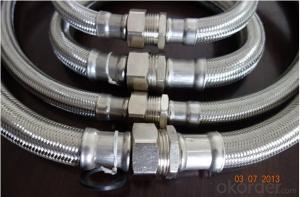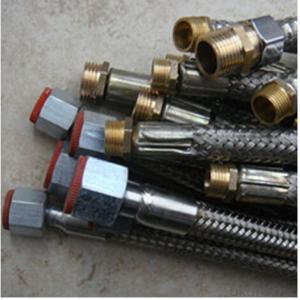Metal Braided Hose for Industrial and Building
- Loading Port:
- Tianjin
- Payment Terms:
- TT OR LC
- Min Order Qty:
- 1000 pc
- Supply Capability:
- 100000 pc/month
OKorder Service Pledge
OKorder Financial Service
You Might Also Like
Item specifice
Metal Braided Hose for Industrial and Building
Applications of Metal Braided Hose for Industrial and Building:
--Refueling system
--Chemical and pharmaceutical industry
--Industrial hydraulic systems
--Air conditioners in industrial and construction –site vehicles
--Food and beverage industry
--Special and standard industrial applications
--Water and cleaning management
Features of Metal Braided Hose for Industrial and Building:
1. )O. D.: 13-18MM 0.2-3M long
2. )Nut.: Nickel/Chrome Plated Brass (Zinc / Iron / Aluminum is available)
3. )Size Of Nut.: Female&Male 1/2''; 3/4''; 3/8''; 7/8''; 5/16'', and M10...
4. )Insert.: Brass (Zinc / Aluminum / Plastic is available)
5. )Inner tube.: Rubber/ EPDM/PVC
6. )Covered Material: Stainless Steel 201, 301, 304 /Aluminium Wire
7. )Working Pressure: 5Kg-15Kg
8. )Temperature: 0-92° C
9. )Quality Assurance: 3 years
RemarkAPPLICATION: HOUSEEHOLD WARE, BATHROOM WARE, SHOWER HOSE
PAYMENT: T/T, L/C
DELIVERY TIME: 20DAYS OR 30DAYS AFTER RECEIVED 30% DEPOSITS
MOQ: 5000PCS
ODM&OEM IS ACCEPTABLE
PackageInner: PP bag /Blister packing Outer: Carton box
Specifications of Metal Braided Hose for Industrial and Building:
NO | I.D | Refer to O.D | Working pressure | Burst pressure | approximate Weight | |||||
(inch) | (mm) | (inch) | (mm) | MPa | Psi | MPa | Psi | kg/m | lbs/ft | |
1 | 1/8 | 3.2±0.2 | 0.35 | 9±0.3 | 2.06 | 300 | 8.27 | 1200 | 0.078 | 0.12 |
2 | 5/32 | 4±0.2 | 0.4 | 10±0.3 | 2.06 | 300 | 8.27 | 1200 | 0.092 | 0.14 |
3 | 3/16 | 4.8±0.2 | 0.43 | 11±0.3 | 2.06 | 300 | 8.27 | 1200 | 0.108 | 0.16 |
4 | 1/4 | 6.3±0.3 | 0.5 | 12.7±0.3 | 2.06 | 300 | 8.27 | 1200 | 0.134 | 0.2 |
5 | 5/16 | 8.0±0.3 | 0.56 | 14±0.3 | 2.06 | 300 | 8.27 | 1200 | 0.147 | 0.22 |
6 | 3/8 | 9.5±0.3 | 0.63 | 16±0.4 | 2.06 | 300 | 8.27 | 1200 | 0.182 | 0.27 |
7 | 15/32 | 12±0.3 | 0.75 | 19±0.5 | 2.06 | 300 | 8.27 | 1200 | 0.238 | 0.35 |
8 | 1/2 | 12.7±0.4 | 0.78 | 20±0.5 | 2.06 | 300 | 8.27 | 1200 | 0.262 | 0.39 |
9 | 5/8 | 16±0.4 | 0.94 | 24±0.5 | 1.03 | 150 | 4.12 | 600 | 0.351 | 0.52 |
10 | 3/4 | 19±0.4 | 1.13 | 28.8±0.5 | 1.03 | 150 | 4.12 | 600 | 0.515 | 0.77 |
11 | 1 | 25.4±0.5 | 1.38 | 35±0.6 | 1.03 | 150 | 4.12 | 600 | 0.637 | 0.95 |
Images of Metal Braided Hose for Industrial and Building:
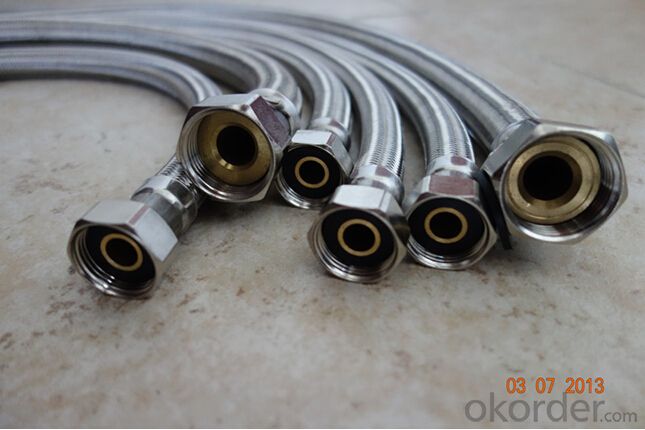
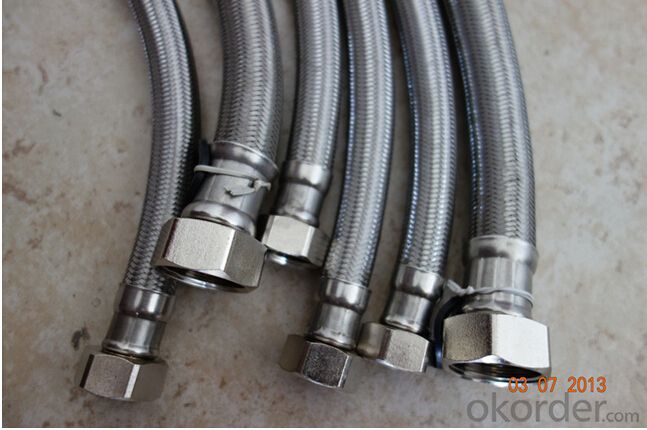
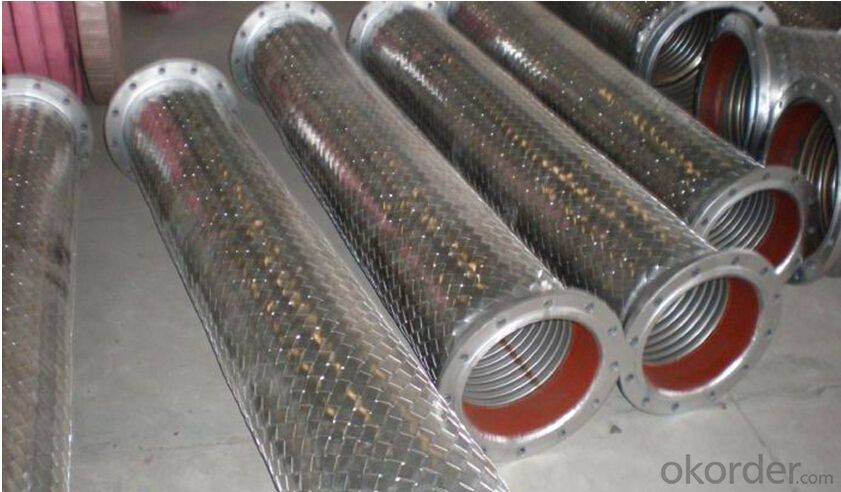
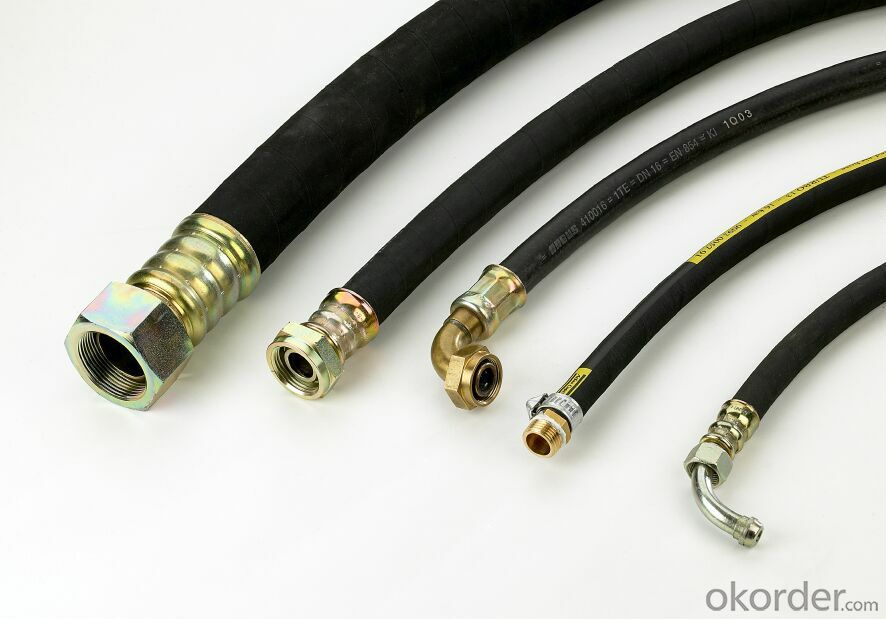
Package of Metal Braided Hose for Industrial and Building:
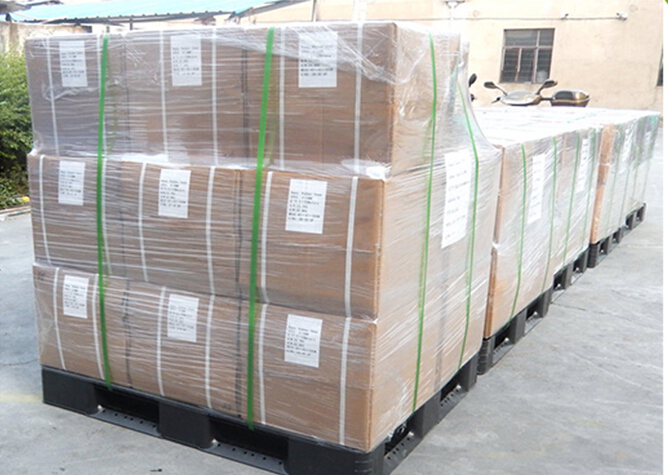
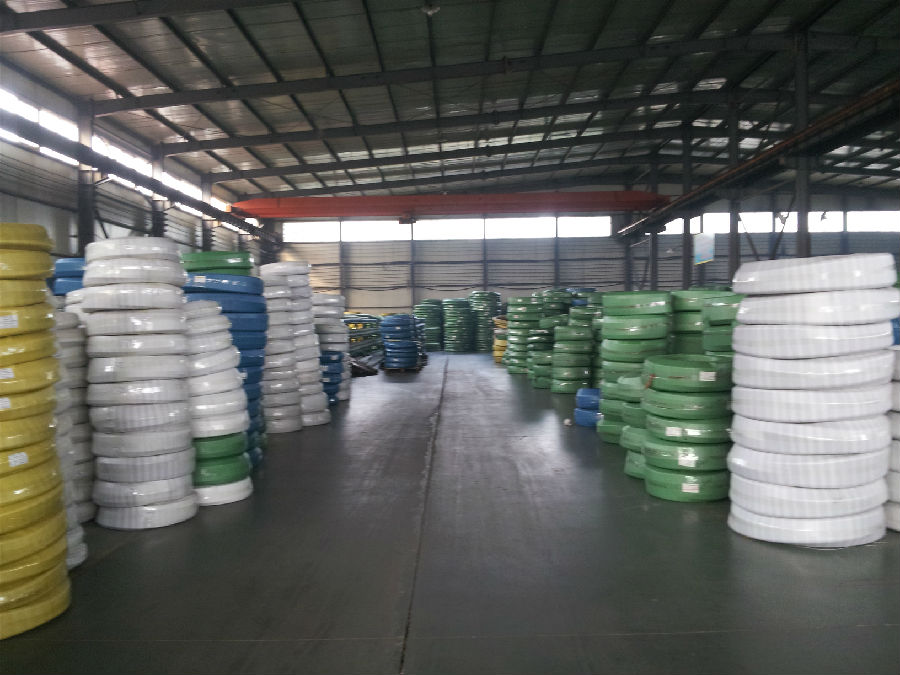
FAQ of Metal Braided Hose for Industrial and Building:
Who we are:
Answer: We CNBM is a Chinese state-owned enterprise ranked 267th among the Global Fortune 500, as the largest building materials company,we have over 300 affiliated companies,and so many production lines and branch office distribute in China.
2. About our quality:
Answer: Every product needs to be quality proved before shipping.
3. About our service:
Answer: We could gurantte that we can reply you in 2 working hours.
- Q:Can stainless steel pipes be used for oil and gas refineries?
- Yes, stainless steel pipes can be used for oil and gas refineries. Stainless steel is a highly durable and corrosion-resistant material, making it suitable for the harsh and corrosive environments found in refineries. It can withstand high pressures, extreme temperatures, and exposure to various chemicals and corrosive substances commonly found in oil and gas operations. Additionally, stainless steel pipes offer excellent resistance to erosion, pitting, and cracking, ensuring the integrity and longevity of the pipeline system.
- Q:What are the different types of stainless steel pipes available?
- There are several different types of stainless steel pipes available, each with their own unique properties and uses. 1. Austenitic stainless steel pipes: This type of stainless steel is the most common and versatile. It contains high levels of chromium and nickel, making it highly resistant to corrosion and oxidation. Austenitic stainless steel pipes are widely used in various industries, including construction, automotive, and food processing. 2. Ferritic stainless steel pipes: Ferritic stainless steel contains high levels of chromium but low levels of carbon, which gives it excellent resistance to corrosion. These pipes are commonly used in applications where high strength and resistance to stress corrosion cracking are required. 3. Martensitic stainless steel pipes: Martensitic stainless steel is known for its high strength and hardness. These pipes are often used in applications that require resistance to wear and abrasion, such as cutlery, tools, and bearings. 4. Duplex stainless steel pipes: Duplex stainless steel is a combination of austenitic and ferritic stainless steels. This type of steel offers excellent corrosion resistance and high strength. Duplex stainless steel pipes are commonly used in industries that require resistance to chloride stress corrosion cracking, such as offshore oil and gas production. 5. Precipitation-hardening stainless steel pipes: Precipitation-hardening stainless steel pipes are heat-treatable and have high strength and corrosion resistance. They are often used in industries such as aerospace and chemical processing, where both strength and resistance to corrosion are essential. These are just a few examples of the different types of stainless steel pipes available. The choice of the right type of stainless steel pipe depends on the specific application and the required properties, such as corrosion resistance, strength, and temperature resistance.
- Q:Mechanical properties of stainless steel tubes
- The phenomenon of deformation due to external forces increases with time is called creep. At a certain temperature, especially at high temperature, the greater the load, the faster the creep occurs. Under a certain load, the higher the temperature and the longer the time, the greater the possibility of creep. On the contrary, the lower the temperature and the slower the creep rate, the less creep is when the temperature is low to a certain temperature. This minimum temperature varies according to the type of steel. In general, pure iron is at about 330 degrees, while stainless steel has been strengthened by various measures, so the temperature is above 550.
- Q:Can stainless steel pipes be insulated with cellulose?
- Indeed, it is possible to insulate stainless steel pipes with cellulose. Cellulose insulation is frequently selected to insulate pipes because of its exceptional thermal resistance and fire-resistant characteristics. It can be employed on a wide range of pipe materials, including stainless steel. There are various methods available for applying cellulose insulation to pipes, including using cellulose insulation blankets to wrap the pipes or filling the pipe cavities with loose-fill cellulose insulation. By insulating stainless steel pipes with cellulose, one can effectively prevent heat loss, decrease energy consumption, and maintain a consistent temperature within the pipes.
- Q:How do you calculate the pressure drop in stainless steel pipes?
- To calculate the pressure drop in stainless steel pipes, you would need to consider various factors such as the flow rate, pipe diameter, pipe length, and the properties of the fluid being transported. The pressure drop can be determined using the Darcy-Weisbach equation, which is commonly used for calculating pressure losses in pipe systems. The Darcy-Weisbach equation is as follows: ΔP = (f * (L/D) * (ρ * V^2))/2 Where: ΔP = Pressure drop (in units of force per unit area, such as psi or Pa) f = Darcy friction factor (depends on flow conditions and pipe roughness) L = Pipe length (in units of length, such as meters or feet) D = Pipe diameter (in units of length, such as meters or feet) ρ = Fluid density (in units of mass per unit volume, such as kg/m^3 or lb/ft^3) V = Fluid velocity (in units of length per unit time, such as m/s or ft/s) To calculate the pressure drop, you would need to determine the Darcy friction factor, which depends on the Reynolds number (Re) and the relative roughness of the pipe. The Reynolds number can be calculated using the following equation: Re = (ρ * V * D)/μ Where: μ = Fluid viscosity (in units of force per unit area per unit time, such as Pa·s or lb/ft·s) Once you have determined the Reynolds number, you can use empirical correlations or Moody's chart to find the Darcy friction factor for the given flow conditions. With the friction factor, pipe length, diameter, fluid density, and velocity, you can then calculate the pressure drop using the Darcy-Weisbach equation. It is important to note that the above equations provide an approximate calculation of pressure drop in stainless steel pipes. The accuracy of the calculation may depend on factors such as pipe roughness, fluid properties, and the flow regime. Additionally, it is recommended to consult relevant standards or engineering references for more detailed and accurate calculations.
- Q:How can stainless steel and copper pipe be welded?
- First, try the test before burning. The brass is directly burned to the stainless steel tube. First feel the heat and see what the stainless steel likes to adhere toWhen stainless steel is not red, copper is not adheredWhen stainless steel is red, do not stick copperOnly when stainless steel is red, copper paste is preferredTherefore, when welding, we must master the size of the furnace, thin and thin pipe, fire should be adjusted to small crude pipe, on the contrary, they feel the proper heat
- Q:What is the difference between seamless and hot-rolled stainless steel pipes?
- Seamless and hot-rolled stainless steel pipes are commonly utilized in various industries due to their durability and resistance to corrosion. Nonetheless, there exist notable distinctions between the two. 1. Manufacturing process: Seamless stainless steel pipes are produced through a technique known as piercing, which involves heating a solid billet and piercing it to create a hollow tube. Conversely, hot-rolled stainless steel pipes are formed by heating a solid billet or slab and subsequently rolling it into the desired shape. 2. Appearance: The manufacturing process of seamless stainless steel pipes results in a smooth and uniform appearance. In contrast, hot-rolled stainless steel pipes possess a rough and scaly surface due to the rolling process. 3. Strength: Generally, seamless stainless steel pipes exhibit greater strength compared to their hot-rolled counterparts. This is attributed to the additional processes such as cold drawing or cold rolling that seamless pipes undergo, which enhance their strength. 4. Wall thickness: The manufacturing process of seamless stainless steel pipes allows for a more precise wall thickness. Conversely, hot-rolled stainless steel pipes may have variations in wall thickness due to the rolling process. 5. Cost: Hot-rolled stainless steel pipes are typically more cost-effective than seamless pipes. This is because the manufacturing process of hot-rolled pipes is simpler and requires less time and energy. 6. Availability: Hot-rolled stainless steel pipes are more readily accessible in the market compared to seamless pipes. This is due to the faster manufacturing process of hot-rolled pipes, which allows for quicker production and availability. In conclusion, while both seamless and hot-rolled stainless steel pipes offer exceptional corrosion resistance and durability, they differ in terms of manufacturing process, appearance, strength, wall thickness, cost, and availability. The choice between the two will depend on the specific requirements and preferences of the application or industry in which they will be utilized.
- Q:Can stainless steel pipes be used for natural gas?
- Yes, stainless steel pipes can be used for natural gas. Stainless steel is highly resistant to corrosion and can withstand the high pressures and temperatures associated with natural gas transmission and distribution. Additionally, stainless steel pipes have excellent fire resistance properties, making them a safe choice for natural gas applications.
- Q:316 stainless steel pipe wall mirror polishing, the smaller the roughness, the better.
- Sanitary grade stainless steel tube and stainless steel sanitary pipe: phi 6 - 219mm * 0.5 - 5mm. The product is cold rolled by three roll tube mill and is polished inside and outside by degreasing and flat drawing. It is a seamless sanitary stainless steel pipe and stainless steel sanitary pipe finished product. The outer surface of the product is polished, the diameter and wall thickness tolerance of less than 0.02-0.05mm, the inner wall of the pipe roughness Ra is less than or equal to 0.6 m after Ra or 0.4-0.25 inner wall polishing m, sanitary stainless steel pipe and stainless steel pipe health features: inside and outside wall of polished, bright surface, very smooth, high dimensional accuracy, delivery status generally hard (micro magnetic), and widely used.
- Q:What does "stainless steel pipe" DN mean?
- Nominal diameter is the size of all piping accessories in the piping system. The nominal diameter is a convenient round integer for reference and is not strictly related to the processing size. The nominal diameter follows the letter "DN" followed by a number sign.
1. Manufacturer Overview |
|
|---|---|
| Location | |
| Year Established | |
| Annual Output Value | |
| Main Markets | |
| Company Certifications | |
2. Manufacturer Certificates |
|
|---|---|
| a) Certification Name | |
| Range | |
| Reference | |
| Validity Period | |
3. Manufacturer Capability |
|
|---|---|
| a)Trade Capacity | |
| Nearest Port | |
| Export Percentage | |
| No.of Employees in Trade Department | |
| Language Spoken: | |
| b)Factory Information | |
| Factory Size: | |
| No. of Production Lines | |
| Contract Manufacturing | |
| Product Price Range | |
Send your message to us
Metal Braided Hose for Industrial and Building
- Loading Port:
- Tianjin
- Payment Terms:
- TT OR LC
- Min Order Qty:
- 1000 pc
- Supply Capability:
- 100000 pc/month
OKorder Service Pledge
OKorder Financial Service
Similar products
New products
Hot products
Related keywords

